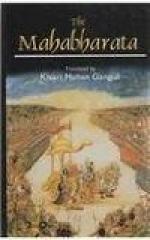“Vasudeva said, ’O mighty-armed Yudhishthira, listen to me as I recite to thee the many names of Rudra as also the high blessedness of that high-souled one. The Rishis describe Mahadeva as Agni, and Sthanu, and Maheswara; as one-eyed, and three-eyed, of universal form, and Siva or highly auspicious. Brahmanas conversant with the Vedas say that that god has two forms. One of these is terrible, and the other mild and auspicious. Those two forms, again, are subdivided into many forms. That form which is fierce and terrible is regarded as identical with Agni and Lightning and Surya. The other form which is mild and auspicious is identical with Righteousness and water and Chandramas. Then, again, it is said that half his body is fire and half is Soma (or the moon). That form of his which is mild and auspicious is said to be engaged in the practice of the Brahmacharya vow. The other form of his which is supremely terrible is engaged in all operations of destruction in the universe. Because he is great (Mahat) and the Supreme Lord of all (Iswara), therefore he is called Maheswara. And since he burns and oppresses, is keen and fierce, and endued with great energy, and is engaged in eating flesh and blood and marrow, he is said to be Rudra. Since he is the foremost of all the deities, and since his dominion and acquisitions are very extensive, and since he protects the extensive universe, therefore he is called Mahadeva. Since he is of the form or colour of smoke, therefore he is called Dhurjati. Since by all his acts he performs sacrifices for all and seeks the good of every creature, therefore he is called Siva or the auspicious one. Staying above (in the sky) he burns the lives of all creatures and is, besides, fixed in a particular route from which he does not deviate. His emblem, again, is fixed and immovable for all time. He is, for these reasons, called Sthanu. He is also of multiform aspect. He is present, past, and future. He is mobile and immobile. For this he is called Vahurupa (of multiform aspect). The deities called Viswedevas reside in his body. He is, for this, called Viswarupa (of universal form). He is thousand-eyed; or, he is myriad-eyed; or, he has eyes on all sides and on every part of his body, His energy issues through his eyes. There is no end of his eyes. Since he always nourishes all creatures and sports also with them, and since he is their lord or master, therefore he is called Pasupati (the lord of all creatures). Since his emblem is always observant of the vow of Brahmacharya, all the worlds worship it accordingly. This act of worship is said to gratify him highly. If there is one who worship him by creating his image, another who worships his emblem, the latter it is that attains to great prosperity for ever. The Rishis, the deities, the Gandharvas, and the Apsaras, worship that emblem of his which is ever erect and upraised. If his emblem is worshipped, Maheswara becomes highly gratified with the worshipper.




